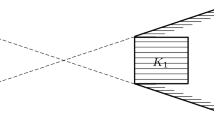Abstract
We utilize the unifying framework of families of convexity spaces for the treatment of various notions of planar convexity and the associated convex hulls. Our major goal is to prove the refinement and decomposition theorems for families of convexity spaces. These general theorems are then applied to two examples: restricted-oriented convex sets andNESW-convex sets. The applications demonstrate the usefulness of these general theorems, since they give rise to simple algorithms for the computation of the associated convex hulls of polygons.
Similar content being viewed by others
References
Bruckner, C.K., and Bruckner, J.B.; “On Ln-Sets, the Hausdorff Metric, and Connectedness,”Proc. Amer. Math Soc.,13, 765–767, 1962.
Cohn, P. M.;Universal Algebra, Harper & Row, New York, 1965.
Dwinger, Ph.; “On the Lattice of the Closure Operators of a Complete Lattice,”Nieuw Archief voor Wiskunde,VI, 112–117, 1956.
Edelsbrunner, H.; “Intersection Problems in Computational Geometry,” Technical University of Graz and Austrian Computer Society, Graz, Austria, Institute für Informationsverarbeitung, Report F 93, 1982.
Güting, R. H.; “Stabbing C-Oriented Polygons,”Information Processing Letters,16, 35–40, 1983.
Grätzer, G.;General Lattice Theory, Birkhäuser, 1978.
Jamison-Waldner, R. E.; “A Perspective on Abstract Convexity: Classifying Alignments by Varieties,”Convexity and Related Combinatorial Geometry, Proceedings of the 2nd University of Oklahoma Conference, (Kay, D. C. and Breen, M., eds.). Lecture Notes in Pure and Applied Mathematics,76, 113–150, 1982. Marcel Dekker, Inc., New York and Basel.
Kay, D. C. and Womble, E. W.; “Axiomatic Convexity Theory and Relationships between the Caratheódory, Helly and Radon Numbers,”Pacific Journal of Mathematics,38, 471–485, 1971.
Klee, V.; “What is a Convex Set?,”American Mathematical Monthly,78, 616–631, 1971.
Levi, F. W. “On Helly's Theorem and The Axioms of Convexity,”Journal of the Indian Mathematical Society,15, 65–76, 1951.
Lipski, W. and Papadimitriou, C. H.; “A Fast Algorithm for Testing for Safety and Detecting Deadlocks in Locked Transaction Systems,” Technical Report MIT/LCS/TM-181, Laboratory for Computer Science, MIT, 1980.
Ottmann, Th., Soisalon-Soininen, E. and Wood, D.; “On The Definition and Computation of Rectilinear Convex Hulls,”Information Sciences,33, 157–171, 1984.
Preparata, F. P. and Shamos, M.I.;Computational Geometry, Springer-Verlag, New York, 1985.
Rawlins, G. J. E. and Wood, D.; “Optimal Computation of Finitely Oriented Convex Hulls,”Information and Computation,72, 150–166, 1987.
Rawlins, G. J. E. and Wood, D.; “Restricted-Oriented Convex Sets,”Information Sciences, 1989, to appear.
Rawlins, G. J. E. and Wood, D.; “Orthoconvexity,”Computational Morphology, (Toussaint, G.T., ed.), 137–152. North Holland, Amsterdam, 1988.
Sack, J.-R.; “Rectilinear Computational Geometry,” Doctoral Dissertation, Carleton University, School of Computer Science, 1984.
Shamos, M. L; “Problems in Computational Geometry,” Doctoral Dissertation, Yale University, Computer Science Department, 1978.
Sierksma, G.; “Extending a Convexity Space to an Aligned Space,”Indagationes Mathematicae,46, 429–435, 1984.
Soisalon-Soininen, E. and Wood, D.; “Optimal Algorithms to Compute the Closure of a Set of Iso-Rectangles,”Journal of Algorithms,5, 199–214, 1984.
Toussaint, G. T.; “Pattern Recognition and Geometrical Complexity,”Proceedings of the International Conference on Pattern Recognition,2, 1324–1347, 1980.
Toussaint, G. T. and Sack, J.-R.; “Some New Results on Moving Polygons in the Plane,”Proceedings of the Robotic Intelligence and Productivity Conference, 158–164, 1983.
Valentine, F.A.; “Local Convexity andL n -Sets,”Proc. Amer. Math. Soc.,16, 1305–1310, 1965.
Widmayer, P., Wu, Y. F. and Wong, C. K.; “Distance Problems in Computational Geometry for Fixed Orientations,”Proceedings of the 1st Annual ACM Symposium on Computational Geometry, 186–195, 1985.
Widmayer, P., Wu, Y. F., Schlag, M. D. F. and Wong, C. K.; “On Some Union and Intersection Problems for Polygons with Fixed Orientations,”Computing,36, 183–197, 1986.
Wood, D.; “An Isothetic View of Computational Geometry,”Computational Geometry, (Toussaint, G., ed.), 429–459. North Holland, Amsterdam, 1985.
Yannakakis, M., Papadimitriou, C. H. and Kung, H. T.; “Locking Policies: Safety and Freedom from Deadlock,”Proceedings of the 20thAnnual IEEE Symposium on Foundations of Computer Science, 286–297, 1979.
Author information
Authors and Affiliations
Rights and permissions
About this article
Cite this article
Rawlins, G.J.E., Wood, D. A decomposition theorem for convexity spaces. J Geom 36, 143–159 (1989). https://doi.org/10.1007/BF01231029
Received:
Issue Date:
DOI: https://doi.org/10.1007/BF01231029




